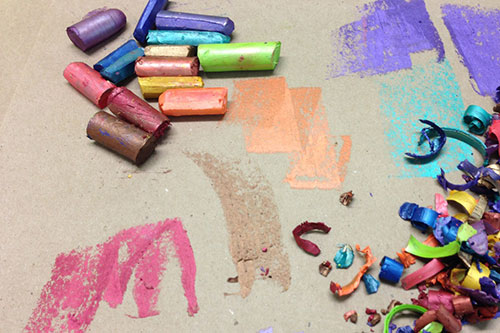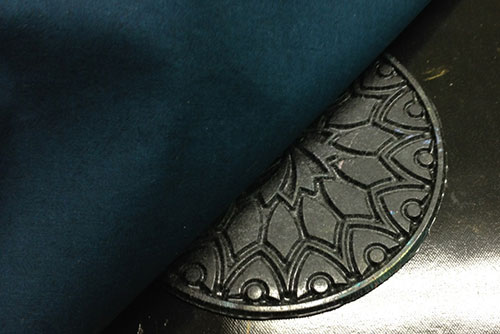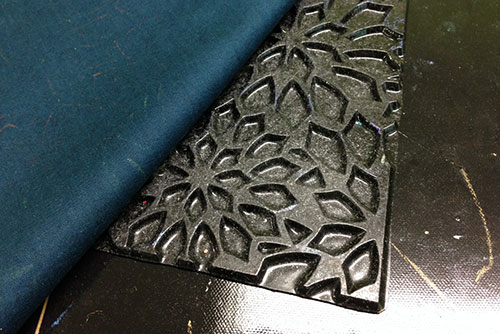Journal
Overlapping Rubbings Tutorial

by Shelly Stokes, Founder and Creative Mentor

 The new Kaleidoscope Rubbing Plates received warm welcome at the Minnesota Quilt Show and the International Quilt Festival in Chicago. Many thanks if you were one of the select group of people who snapped one up at the shows or placed your order during our promotion. I know you will love them!
The new Kaleidoscope Rubbing Plates received warm welcome at the Minnesota Quilt Show and the International Quilt Festival in Chicago. Many thanks if you were one of the select group of people who snapped one up at the shows or placed your order during our promotion. I know you will love them!
Jim Huebener, better known as Mr. Laura Murray, finished up his “yard” of Kaleidoscope fabric while demonstrating at the two quilt events. You have to give him credit — he really knows his paintstiks!
I have had a number of people ask how to make these overlapping images, so here is your tutorial. It is a bit long due to a lot of pictures, but it is just the ticket if you want to create your own Kaleidoscope fabric. Let’s get started!
The first step is to press your fabric. Wrinkles will show up in your rubbings, so it pays to get off to a proper start. I used a piece of fabric that was about 18” square. A fat quarter from your stash is perfect for this experiment.
I trimmed the corners off the plates with the circular designs, and followed Jim’s lead in trimming the one plate so that it has a scalloped edge. I will show you that in just a moment. Give your plates a good coating of sticky spray and allow the spray to dry for a minute before you start painting.
Next, you will need to grab a selection of Paintstik Minis (or pieces of full size sticks) and peel the film from the side of each of the sticks. I chose warm colors and cool colors for this tutorial, all from the Iridescent Paintstik line.
Tip: Inexpensive kraft paper is a great tool to contain your paint mess. Once I have my paints peeled open, I move them to a fresh sheet of paper. Then I roll up the paper with the paint peelings and toss it in the trash bin.
Now that we have the prep work out of the way, it is time to paint. Place a Grip-n-Grip mat on your work surface, add the first rubbing plate, lay your fabric over the plate, and press the fabric onto the rubbing plate. The sticky spray will hold it in place.
Using one of your Paintstiks, make a very light rubbing. This allows you to see both the edges of the plate and the placement of the design elements. I often call this a “shadow” rubbing. I make them as light as possible as I know I am going to paint over them with different colors.
Starting in the middle of the rubbing plate, add your first color. Do not worry about getting some color on the next ring of design elements.
Choose the color for the next ring of design elements, and add paint. Work from the center toward the outside of the plate to avoid shifting the fabric.
Continue working until you reach the edge of the plate and you are happy with your color choices.
Here is my first full circular image.
Now it is time to paint the next image. Place a rubbing plate under your fabric, several inches away from the first medallion. Again, start with a very light “shadow” rubbing.
Working from the inside to the outside, add as many colors as you want to the medallion.
Continue adding full medallions here and there on your fabric. For my 18” square of fabric, three full images was just about right. This photo also shows the plate with the “scalloped” edges.
Now we can start adding the “filler” images.
Place a rubbing plate under your fabric so that it is under at least one of the full medallions. Make a “shadow” rubbing of this plate, being careful not to paint over the existing images. I find it helpful to position my paintstik next to the edge of the first image and paint away from that edge.
This may seem awkward at first, but it gets much easier with practice. Give yourself permission to “play” with a fat quarter of fabric and you will be a pro in no time!
Here is the partial rubbing. See how it appears to be “behind” the first two images?
Continue painting, adding partial rubbings to fill your fabric. You can either fill the entire fabric with images from the medallion plates, or you can leave some blank spaces to be filled in with the background plate.
To add background images, place the Starburst Plate under an open space in your fabric, then make a rubbing to fill in that space. Repeat this step until you have filled in all of the open areas of your fabric.
As you can see, filling in the spaces with the Starburst Plate is a nice touch. I like the way it pulls everything together.
Ta Da!
If you have been following along, you now have a pretty cool piece of fabric! Give yourself a pat on the back. Your first piece of Kaleidoscope fabric may not be a masterpiece, but by giving yourself permission to play, you should be set to create lovely fabric with overlapping rubbing plate images. Good for you!
Resources
To create your own overlapping Kaleidoscope fabric, you will need the following:
- Iridescent Paintstik Colors (minis or pieces from the full sticks work fine)
- Kaleidoscope Rubbing Plates
- One fat quarter (18 x 22) of dark colored fabric from your stash
- Grip-n-Grip mats
- 404 Spray and Fix sticky spray
- Cedar Canyon Brush Soap (to clean your hands)

















You make it look so easy! I know that there is some practice needed and so I will practice ….a lot! ahahahahah It is absolutely the coolest designs. I can’t wait to get mine started!
Hey Debbie — you hit the key word there — practice. You have to remember that I have been playing with Paintstiks for 15 years. I really wish I had saved some of my early stuff. It would be fun to compare after many years of practice. 🙂
Thank you so much! I bought the templates at st. cloud, quilt show, and tried it at home , & it didn’t look so good can see several things I did wrong, ready to try again!
That’s great, Colleen. I’m so glad you found the tutorial helpful.
When I first saw this piece, I couldn’t figure out how you did it, but after reading the tutorial, I noticed that if you realize you are working from the top layer of the design down through several layers, it makes more sense and is easier to visualize. As you add rubbings, you are actually making layers “under” your first 3 rubbings. I can’t wait to try this!!
Hi Linda, You are absolutely right. The first layer of medallions is “on top,” and the subsequent layers are “underneath.” Now I just have to remember that when I am choosing colors. Bright on the top and quieter in the background layers. If I do it often enough, I’ll figure it out…
YOU DON’T DEFINE OR EXPLAIN WHAT A “SHADOW RUBBING” IS.PLEASE ADD THIS INFORMATION TO CLARIFY YOUR EXCELLENT AND INSPIRATIONAL TUTORIAL.
IS THIS A TRUE KALEIDOSCOPE OR IS THERE MORE THAN ONE DEFINITION?
Hi Ellen, A “shadow” rubbing is simply a very, very light rubbing. To make these, I run a paintstik over the rubbing plate using the least amount of pressure that will still produce an image as I know I am going to paint over it with different colors.
As for the term Kaleidoscope, I would wager that none of these images could truly be created by a real kaleidoscope. I was looking for a name that people could instantly identify with and my husband said “they look like kaleidoscope images to me.” So that’s how the set got its name. 🙂
[…] I told you about my process for creating overlapping rubbings from the new Kaleidoscope plates. (Click here to read that article if you missed it.) This week, I am happy to show you my beautiful new […]